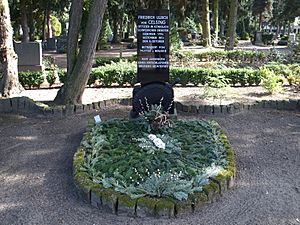Combat of Rosslau facts for kids
Quick facts for kids Combat of Rosslau |
|||||||
|---|---|---|---|---|---|---|---|
| Part of the War of the Sixth Coalition | |||||||
 The grave of Friedrich Ulrich von Celsing, a Swedish soldier who died as a result of the battle |
|||||||
|
|||||||
| Belligerents | |||||||
| Commanders and leaders | |||||||
| Strength | |||||||
| 7,000 | 4,300 | ||||||
| Casualties and losses | |||||||
| 700–1,500 killed, wounded or captured | 350 killed, wounded or captured | ||||||
The Combat of Rosslau was a battle that happened on September 29, 1813. It took place near Rosslau, Germany. This fight was part of a bigger conflict called the War of the Sixth Coalition. In this battle, French forces led by Michel Ney attacked a Swedish position. The Swedes, commanded by Johan August Sandels, fought back. The Swedes chased the French for about 5 kilometers (3 miles).
Around 350 Swedish soldiers were killed or wounded. The French lost many more, with about 700 to 1,500 killed, wounded, or captured. Even though it was a Swedish victory, this battle did not change the overall plan of the war. However, it was one of the few times Swedish troops were fully involved in a major fight during this war.
Why the Battle Happened
Before the battle, French forces under Michel Ney had orders from Emperor Napoleon I. Napoleon wanted Ney to attack a Swedish "bridgehead" at the Elbe river. A bridgehead is a strong position on the enemy's side of a river, protecting a bridge. The goal was to stop the "Army of the North" from crossing the river and reaching Leipzig.
Ney's troops, about 7,000 to 8,000 strong, marched towards the Swedish left side. The Swedish forces, led by Johan August Sandels, had about 4,000 to 4,500 men. These included soldiers from the Skaraborg, Älvsborg, and Västgöta infantry regiments, plus some Värmland jägers (light infantry).
The Battle Begins
On September 29, Ney's forces attacked the Swedish outposts early in the morning. The Swedish soldiers fought for several hours but eventually had to fall back. During this time, Sandels got his men ready. Instead of waiting behind their defenses, he decided to launch a surprise counterattack.
One Skaraborg battalion and some jägers marched directly at the French. They stopped about 30 meters (100 feet) away and fired a powerful "volley" (many shots at once). This surprised the French, who pulled back to a nearby forest. A fierce gunfight then began.
Swedish Counterattack
When two more Skaraborg battalions joined the fight, the Swedes felt strong enough to charge. They used "bayonets" (knives attached to rifles) to push the French back into the forest. The Swedes chased them for almost 5 kilometers (3 miles).
As the French retreated, they received more and more backup. This allowed them to finally stop the Swedish advance. The Swedes, now outnumbered, had to pull back towards their bridgehead. The French also set up cannons that fired at the Swedes from the side, causing many casualties.
What Happened After
The Swedish army lost about 350 soldiers, killed or wounded. The Skaraborg regiment alone had 44 killed and 241 wounded. Swedish reports say the French lost at least 1,500 men. Many of them were killed during the chase through the forest. It's said that 700 to 800 dead French soldiers were buried in Dessau. The Skaraborg infantry regiment was especially praised for its bravery.
Later, Ney returned to the Swedish bridgehead with his army. He decided not to attack again. Instead, he tried to block the Swedish defenses. This effort was eventually stopped when news arrived that the Allied armies had crossed the Elbe river at Wartenburg on October 3. After crossing the river, the Allied armies were able to surround Napoleon's forces. They then defeated him in a very important battle, the Battle of Leipzig, from October 16 to 19, 1813.
The Swedish Crown Prince, Charles John, often avoided sending his Swedish troops into big battles. He wanted to save them for future plans, like invading Denmark and fighting in Norway. Because of this, the actions of the Swedes in battles like Rosslau were sometimes overlooked in history books. Even though the Combat of Rosslau didn't change the war's big picture, it was one of the few times a large Swedish force fought fully in the war.

